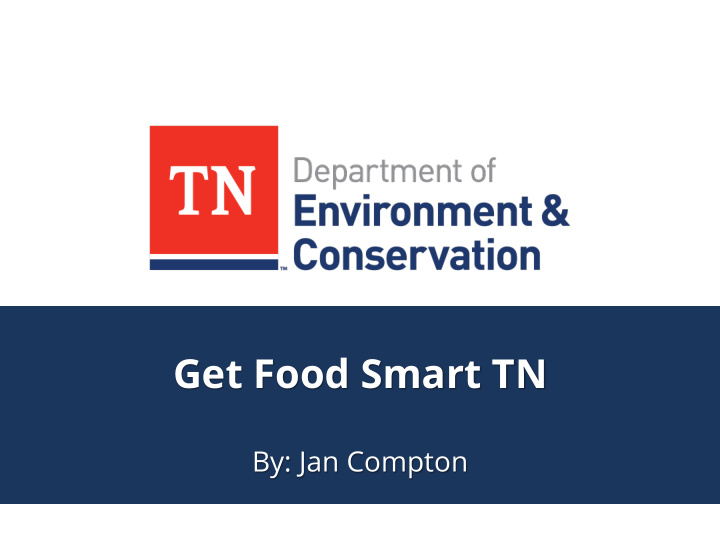



Get Food Smart TN By: Jan Compton
• The story of the Strawberry from NRDC • https://www.youtube.com/watch?v=jKQPL16WjHs&feature=y outu.be
Food Waste in the U.S.
Food Waste • Only 5% of wasted food is diverted from landfills or incinerators. • Americans waste enough food to fill the Rose Bowl every day. Advancing SMM: Facts & Figures 2014
Economic Impact • The retail value of food waste from American consumers is estimated at $115 billion = • $1.3 billion spent landfilling household food waste • The average household wastes $2,275 per year • That’s $190 per month USDA 2014
Environmental Impact • Waste of resources (land, labor, water, energy). • 42% of U.S. greenhouse gas emissions. • 25% of fresh water use. • If food waste were a country, it would be the 3 rd highest emitter. Food and Agriculture Organization of the United Nations
Food Waste Opportunity
US 2030 Food Loss and Reduction Goal • EPA set the goal to reduce food waste by HALF by 2030. • Seeking to work with communities, organizations, and businesses along with partners in state and local government. • By participating in the U.S. 2030 Food Loss and Waste Reduction Goal , the US can help feed the hungry, save money for families and businesses, and protect the environment.
Seeking Solutions • TDEC: 2015-2025 Solid Waste & Materials Management Plan • Update goals and measure progress • Increase Access to and Participation in Recycling • Enhance Processing and End Markets • Increase Diversion of Organics • Support New Diversion Technology • Expand and Focus Education and Outreach • Ensure Sufficient and Environmentally Sound Disposal • Develop Sustainable Funding Sources for Sustainable Materials Management
Seeking Solutions Representative Kevin Brooks • Resolution House Joint Resolution 514 • Resolution encouraging the donation of excess wholesome food in Tennessee • Bill Emerson Good Samaritan Food Donation Act protects good faith food donors • Endorses Get Food Smart TN
Seeking Solutions Governor Haslam: “The Get Food Smart TN campaign is leading the charge of addressing food recovery in Tennessee. We want to encourage all Tennesseans to buy what you need, eat what you buy, and share what you don't. From farmers that grow our food to homes that prepare it, all Tennesseans benefit from reducing food waste.”
Mission Statement: Get Food Smart TN seeks to promote using food wisely and enhancing the sustainability of Tennessee’s food resources.
www.getfoodsmarttn.org
Website Components • About • Act: How you can help • Donate (map) • Recognize • Pledge: Stand with us
Get Food Smart TN Recognition Program • Participants of Get Food Smart TN will be recognized for their work in reducing, recovering, or diverting food waste. – Door placarding – Website features – Awards • We need your input! – Survey
Get Food Smart TN Pledge • One program where individuals can make a difference • What can you commit to?
Food Waste Reduction
How to Reduce Food Waste
Food Waste Reduction Techniques • Meal Planning • Food Purchasing • Produce Selection • Buy Local • Storage Techniques • Food Preservation • Food Reuse/Repurposing • Donation
Meal Planning • Take inventory of items in pantry and freezer. • Keep a meal planner. • Keep a meal bank of fool proof, fast, and easy recipes. • Create “theme night” dinners. • Ask family members for meal suggestions and favorites. • Consider work and activity schedules. • Check the weather.
Why Meal Plan? • Reduces food waste • Saves time and money • Lowers stress • Results in healthier eating
Weekly Meal Planning • Shop your kitchen first • Repurpose leftovers • Be realistic • Include quantities on your list
Food Purchasing • Use a system to identify over- purchased food items and avoid excess wasted food. • Implement a “just -in- time” purchasing system to only purchase what is needed when it is needed. • Plan ahead when purchasing. Consider appointments, schedules, and trips before buying groceries. • Make a grocery list and stick to it.
Produce Selection • Reduced for quick sale • Ugly produce • Farmer’s market
Buy Local
Storage Techniques
Storage Techniques- Shelf Life • Dates are Guidelines- expiration, sell by, best by • Use your sense of smell, sight, and taste to evaluate all items before trashing them. • There are no federally- mandated requirements for dating food other than baby formula.
Food Preservation • Produce Preservation • Shelf Life Extenders
Food Preservation • Canning • Freezing • Dehydrating
Freezing How to Freeze? • Vacuum Sealer • Freezer Bags • Plastic/Aluminum Containers
Things You Didn’t Know You Could Freeze • Cheese • Pasta • Pesto • Homemade Pancakes or Waffles • Rice • Flour • Corn • Soups • Broth/Stock • Milk/Buttermilk • Juice • Dough
Dehydrating What to Dehydrate? • Herbs • Fruits • Vegetables • Meats
Food Reuse/Repurposing • Reusing leftover food can save money and reduce waste. • Creatively repurpose leftovers and trimmings to efficiently use excess food for other meals. • Menu planning that accommodates the use of excess food from previous meals is key to success.
Donation Donate or Share Food with food banks, local charities, co-workers, neighbors, etc.
Contact Information QUESTIONS Jan Compton 423-534-0730 Jan.compton@tn.gov
Recommend
More recommend